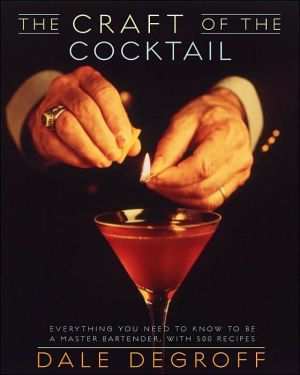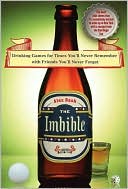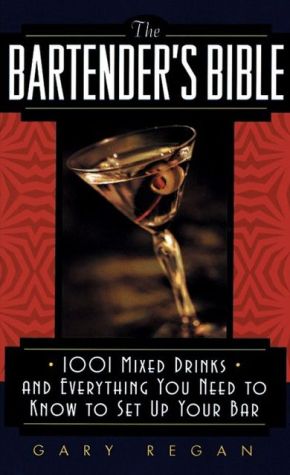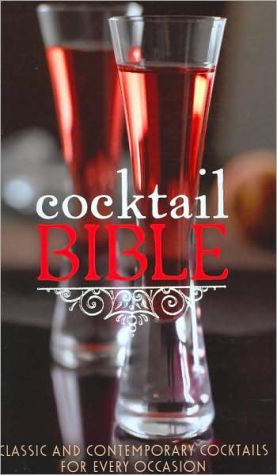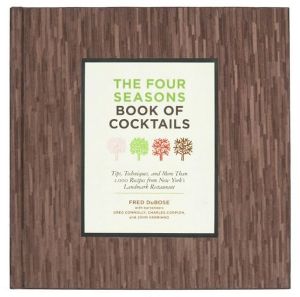Craft of the Cocktail: Everything You Need to Know to Be a Master Bartender, with 500 Recipes
Cocktails are bigger than ever, and this is the first real cookbook for them, covering the entire breadth of this rich subject. The Craft of the Cocktail provides much more than merely the same old recipes: it delves into history, personalities, and anecdotes; it shows you how to set up a bar, master important techniques, and use tools correctly; and it delivers unique concoctions, many featuring Dale DeGroff’s signature use of fresh juices, as well as all the classics.\ Debonair, a great...
Search in google:
Cocktails are bigger than ever, and this is the first real cookbook for them, covering the entire breadth of this rich subject. The Craft of the Cocktail provides much more than merely the same old recipes: it delves into history, personalities, and anecdotes; it shows you how to set up a bar, master important techniques, and use tools correctly; and it delivers unique concoctions, many featuring Dale DeGroff’s signature use of fresh juices, as well as all the classics.Debonair, a great raconteur, and an unparalleled authority, Dale DeGroff is the epitome of Perfect Bartender, universally acknowledged as the world’s premier mixologist. From Entertainment Weekly and USA Today to the Culinary Institute of America and the nation’s best restaurants, whenever anybody wants information or training on the bar, they turn to Dale for recipes, for history, for anecdotes, for fun—for cocktail-party conversation as well as for cocktails.That’s what The Craft of the Cocktail is—the full party, conversation and all. It begins with the history of spirits, how they’re made (but without too much boring science), the development of the mixed drink, and the culture it created, all drawn from Dale’s vast library of vintage cocktail books. Then on to stocking the essential bar, choosing the right tools and ingredients, mastering key techniques—hints worthy of a pro, the same information that Dale shares with the bartenders he trains in seminars and through his videos. And then the meat of the matter: 500 recipes, including everything from tried-and-true classics to of-the-moment originals. Throughout are rich stories, vintage recipes, fast facts, and other entertaining asides. Beautiful color photographs and a striking design round out the cookbook approach to this subject, highlighting the difference between an under-the-bar handbook and a stylish, full-blown treatment. The Craft of the Cocktail is that treatment, destined to become the bible of the bar.
THE HISTORY OF THE COCKTAIL\ I learned abut cocktails much the same way I learned to tend bar. Certainly through research, but mainly through experience.\ My fellow bartenders taught me how to treat people, my customers taught me about life, and most important, my mentor, the great restaurateur Joe Baum, taught me how little I knew. Joe sparked my curiosity to find out what makes a great cocktail.\ The cocktail is, in a word, American. It's as American as jazz, apple pie, and baseball; and as diverse, colorful, and big as America itself. Indeed, it could even be argued that the cocktail is a metaphor for the American people: It is a composite beverage, and we are a composite people. Let's begin by looking at what preceded its invention.\ The early days\ Before Europeans settled in America, they had been cultivating beverage traditions for centuries. Southern Europeans, around the Mediterranean, produced wine and brandy, while distilled-grain spirits were part of the tradition and culture of the peoples who inhabited the northern tier of Europe, where it was too cold for wine grapes to grow. Interestingly, the distillates produced with fermented grape and grain mash were also revered for their "medicinal" qualities, and came be known as aqua vitae in Latin, eau-de-vie in French, usquebaugh in Gaelic, and "water of life" in English. Naturally, as the technology of distilled spirits from grain and grape advanced, water of life could be produced more cheaply and in greater quantities, and eventually it was used to produce flavored cordials and liqueurs.\ Once the Europeans established themselves on this side of the Atlantic, they put to good use the beer- and wine-making skills they had brought with them from the Old World. They also brought the Old World opinion that drinking water was unwholesome, even dangerous. The early colonists were voracious experimenters, fermenting beverages from practically everything they could get their hands on: pumpkins, parsnips, turnips, rhubarbs, walnuts, elderberries, and more. They flavored their beer with birch, pine, spruce, and sassafras. They planted apple orchards everywhere from Virginia northward to produce cider and, more important, applejack, which provided the base for many early colonial drinks. Applejack was also popular because it could be made without the use of expensive distilling equipment. Fermented apple juice, or hard cider as it was called, was left out in the cold in late fall and early winter. As layers of ice formed on the surface of the cider, they were skimmed off, removing the water content and thus concentrating the alcohol in the remaining liquid.\ Conversely, as trade between the Old and New worlds increased, Europe in turn discovered the plants and botanicals that the colonists were well on their way to exploiting. As early as 1571, a Spanish doctor named Nicolas Monardes published a document describing plants and medicines from the Americas that were being assimilated into daily life all over Europe. In Italy and France, these plants eventually found their way into fortified and flavored wines, such as vermouth and other apéritif wines. Ironically, these products made their way full-circle across the Atlantic, where they later played a pivotal role in the growth of the cocktail tradition.\ That cocktail tradition began with rum. Distilling spirits began commercially in the New World in 1640 when Wilhelm Kieft, the director-general of New Amsterdam (now Manhattan), erected the first still in which to distill gin and a tavern in which to sell it. When Manhattan fell into the hands of the English, the still was used to make rum, the first internationally accepted spirit of the New World. But truth be told, rum was sort of an accident. Christopher Columbus introduced sugarcane to our hemisphere on his second voyage for the purpose, of course, of making sugar. Rum was made by the ever-industrious colonists as a way to utilize the molasses left over from sugar production-that is, rum was a by-product of sugar. But by the end of the seventeenth century, rum production dwarfed sugar production to such an extent that the British enacted laws requiring that a certain proportion of all sugarcane crops must be used to make actual sugar. Rum had become the base for many colonial beverages, especially punches, and was produced throughout the Caribbean, South America, and to a great extent even in New England.\ The production of rum fueled the growing economy. By 1733 it surpassed all other exports from the colonies. At the time, New England rum distillers were purchasing the molasses from the cheapest sources in the Caribbean, which were more often than not French and Portuguese. As a result, the British rum distillers who were sourcing their own molasses were losing a market share to the upstart colonial distillers and their cheaper molasses, and hence cheaper rum. In retribution, the British passed the Molasses Act of 1733 to control and tax the flow of molasses into the colonies. The Sugar Act followed, and then in 1765 the Stamp Act, which required the use of a tax stamp on all transactions. These acts led to the founding of the First Continental Congress, and eventually to the Revolutionary War. So, you see, it was rum, not tea, that precipitated our break from Great Britain. (Well, maybe there were a few other minor concerns, but this is a book about cocktails, not textiles.)\ The American victory over the British left the new republic deep in debt. To the astonishment of most of his colleagues in the new government, Alexander Hamilton, our first Secretary of the Treasury, decided to pay our war debts quickly by way of a federal excise tax on rum and spirits, which was passed by the Congress in 1791 and signed into law by President George Washington. Thus began the tradition of paying for our wars by taxing our spirits. This would prove handy when, just twenty years later, the new nation found itself at war again with Great Britain in 1812. For the second time in the nation's brief history, the British blockaded our coastline, cutting off trade with molasses producers in the Caribbean and all but finishing the dwindling rum distilleries. This led to a tidal increase in the domestic production of grain spirits, and eventually to the birth of the second American spirit, bourbon, our all-American corn whiskey.\ It was also during the period between these two wars that the word cocktail seems to have come into use. If you ambled into a colonial New England inn for a cold one, or just as likely a hot one, you'd probably order a ratafia, shrub, turnip wine, posset, pope, bishop, sack, flip, or an ale. Are any of these cocktails? Not really. But they were the progenitors of the cocktail, which made its official debut in print in 1806 in a publication called The Balance and Columbian Repository. In a letter to the editor, a reader had queried the meaning of a new word, cocktail. The editor wrote back:\ "Cocktail is a stimulating liquor, composed of spirits of any kind, sugar, water and bitters. It is vulgarly called a bittered sling and is supposed to be an excellent electioneering potion, in as much as it renders the heart stout and bold, at the same time that it fuddles the head . . . It is said also, to be of great use to a Democratic candidate because, a person having swallowed a glass of it, is ready to swallow anything else."\ The sarcastic last line of that reply addresses the practice of plying voters with alcohol, a tradition said to have begun with George Washington that did not end officially until Prohibition. The editor's reply also gives us for the first time a clear distinction between what constitutes a cocktail and separates it from all the concoctions that came before it: the addition of bitters. Bitters is a generic term for alcoholic beverages distilled or infused with plant or root extracts. Native Americans taught the early settlers how to use indigenous plants for flavorings in beverages and for medicinal purposes. Eventually, Old World plants were incorporated into these heady infusions, some of which included gentian root, colombo root, cinchona bark (quinine), ground ivy, horehound, cassia, wormwood, and angostura bark and root. Historically, these infusions were promoted as medicine to beat the tax on alcohol, though they did serve as effective digestifs. What they really did, however, was enhance the flavor of mixed drinks to which they were added.\ The first commercially produced bitters was probably Peychaud's, made by Antoine Amédae Peychaud, a Creole immigrant to New Orleans who operated a pharmacy on the French Quarter's Royal Street from around 1793 through the 1830s. Peychaud himself made his bitters on a small scale but in 1840 the product was manufactured and sold nationally and internationally. With his background as an apothecary, Peychaud was a natural mixologist who delighted the friends who gathered for late-night revelry at his pharmacy. Peychaud would mix cognac and a dash of his secret bitters for his guests in a two-sided eggcup called a coquetier, pronounced "cock-tyay." Sound familiar? It is very likely that this word evolved into the word cocktail in English, but there are countless other tales with the same claim. Regardless of what Peychaud called his concoction, it evolved into the anise-scented Sazerac-sans absinthe, of course.\ The transition from rum to whiskey was well under way long before the British again tried to choke off America's molasses supplies. The immigrants who fled the famines in the British Isles in the early eighteenth century found the New England states less than welcoming, and many of them settled along the frontier of western Pennsylvania. While the Quaker and Dutch colonists settled early on in Pennsylvania to escape the Puritan intolerance of New England, the hardy Scots pushed even farther west, opening up new wilderness and clearing lands for small farms. Naturally, many of them were schooled in the art of distilling whiskey from the old country, and brought small stills with them. Others simply built their own stills out of necessity, as whiskey was used in commerce in place of cash. Goods were purchased and debts were settled with Monongahela, as the whiskey came to be known, named for the river that marked the western frontier at that time.\ Later, Hamilton's heavy tax on spirits drove many distillers out of the colonies altogether and to the frontier territories that would become Kentucky, Tennessee, Ohio, and Indiana. These territories were ideal for whiskey production: The soil was rich, crop yields were higher than in the east, and there was a plentiful supply of pure mineral water bubbling up through the limestone shelf. Savvy settlers cleared the land and planted corn, which was indigenous and offered greater return per acre than other grains. From corn they made corn whiskey, which they barreled and sent down the river by barge to New Orleans. Depending on the distance and the water level of streams and rivers, the barrels of whiskey were sometimes in transit for many months. Completely by accident, whiskey makers discovered the benefits of barrel aging. Prior to the invention of the steam engine, all barge traffic on the river went in one direction only-south toward the gulf-on flatboats and barges, very slowly. But with the advent of steam-powered riverboats and canals, in the middle of the nineteenth century, northern routes were opened to the lucrative eastern market. Whiskey production benefited from easier access to the big markets of the north and east. This development was followed by revolutionary advances in the technology of distilling (brilliantly documented in Michael Kraft's important book, The American Distiller) 1804, that led to the growth of large distilleries that replaced small farmers as the main source of whiskey from "the West." It was also at this time, around 1833, that the word Bourbon first appeared on whiskey labels, a tribute to the French who fought side-by-side with Americans in the Revolution. French names were popular throughout the colonies and the frontier. Everything from streets in New York City to cities on the frontier like Louisville and Lafayette were renamed to honor our French allies.\ The golden age\ When the war with Britain ended in 1815, spirits were heavily taxed again to pay for the war, but not for too long. In 1817, with the debt settled, all excise taxes on domestic spirits were repealed, and for over forty years-up until the Civil War-the spirits industry enjoyed a tax-free growth period. This finally set the stage for what would become known as the golden age of the cocktail. Bars and saloons flourished during this period. In 1832, the Pioneer Inns and Taverns Law created a new type of license that allowed inns to serve alcoholic beverages without being required to lease rooms. This made official what had been happening ever so quietly after colonial-era regulations relaxed after the Revolutionary War: The bar was officially open for business. The floodgates were now open.\ The Industrial Revolution that swept the western world in the nineteenth century had a powerful impact on every facet of American life, and the alcoholic-beverage industry benefited greatly. Factories lured people to urban centers around the country and fostered a sea change in the way people ate and drank and gathered. As cities grew larger, restaurants-without inns-became an important part of the urban landscape. Mass immigrations took place between 1820 and 1855, bringing people from Scotland, England, and Ireland and from Germany and other Central European countries directly to the bustling cities. Like the colonists before them, these new Americans brought with them their distilling and brewing skills and their love of the communal tradition of the public house and taproom.\ The new immigrants typically lived in the worst areas of these urban centers. But many prospered by creating their own social clubs, stocked with gallons of illegal spirits that they occasionally sold to the neighborhood at large. These unlicensed establishments were a phenomenon referred to as "blind pigs" or "blind tigers." The gimmick was that you paid a certain amount of money "to see the blind pig," and as a bonus you were served a free drink. The goal of these wily merchants, of course, was to get enough people to pay to see the pig so that they could open legit establishments. These neighborhood bars and saloons, often two or three to a block, were central to community and precinct politics, serving as community living rooms where men gathered to talk politics.\ The emergence and popularity of neighborhood bars in New York had the blessing of Tammany Hall, the city's notorious political machine. The political bosses of the day were happy to grant the Irish and German immigrants licenses to operate saloons, not for the financial return but because they could control the ward politics by controlling the saloons, where for the most part the voting males spent their free time. With time, the saloon owners became the power brokers in their precincts.\ By the 1870s, the bar business was big business, in full swing, and cocktail books and manuals were flooding the market. Cocktail bars of every description were flourishing in the big cities, from neighborhood haunts to the fancy palaces in big hotels. One of the most stunning bars in New York was the Hoffman House, with towering ceilings and a fifty-foot ornate mahogany bar, marble floors and walls, cigar counters, and oyster bars. The barmen, pristine in their starched white jackets, were skilled practitioners trained in every aspect of beverage and service. Somehow, all the elements fell into place: the technology of refrigeration, charged water (just another word for soda water, water is literally charged with gas), tap beer systems, and the perfecting of mechanical ice systems; the amazing variety of bottled spirits available, both imported and domestic; a large, motivated, and well-trained work force; and a growing industrial economy fueling consumer spending. This was the height of the cocktail's golden age, when many of the classics were either born or perfected: the Martini, the Manhattan, the sour, the fizz, the old fashioned, the Pousse Café, the sling, and the julep. Many remain classics today.\ This was the era of the consummate professional-the Barman. Service became as important as what was being served. The competition was intense, with bars opening on every corner. What separated success from failure was quality and service. In his 1888 Bartender's Manual, Harry Johnson wrote a chapter entitled "How To Attend Bar," in which he chides the novice to supply ice water immediately with every drink, to mix drinks above the counter where the guest can see, and to mix them in such a way as to be "neat, clean, and scientific." He also says that professionalism affords a bit of showmanship when he instructs to "mix in such a way as to draw attention." Finally, Johnson instructs the bartender to be a caring friend: "If you think a customer is about spending for a beverage, when it is possible that he or his family needs the cash for some other more useful purpose, it would be best to give him advice rather than a drink, and send him home with an extra quarter instead of taking the dime for a drink from him."
